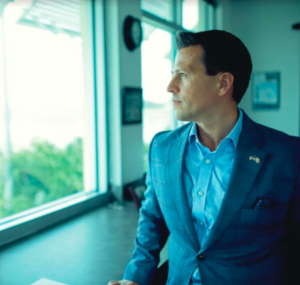
Teri Hansen
One person can’t be responsible for everything. That’s a lesson Teri Hansen learned as Priority Marketing— the Fort Myers marketing, advertising and public relations firm she founded in 1992—began growing quickly a few years ago.
“Up until about our 24th or 25th year, we basically had a very flat organization,” she says. “Everyone reported to me, and I was working to grow and develop every individual within the company. And at some point, it became just impossible to really build an organization that way.”
That’s when Hansen knew she had to develop a leadership plan for the company, which now has 40 employees, so that she wasn’t the only one with all the responsibility. She identified a leadership team whose members would take charge of certain areas, and hired a coach to help with the company’s structure and leadership training.
“I had to have leaders who I trust who can be the ones to coach and develop and continue to build the teams underneath them,” she says.
“Because it’s impossible for one person to do it all. Once you reach a certain size, if you’re really going to grow and develop people, you’ve got to give them more responsibility and give them chances to be leaders.”
Leadership is something that every business owner and executive knows is important. But that capacity to direct and guide others is not always easy to define or achieve.
Heather Christie, president of Naples-based business and executive coaching firm Evolve Global, uses a definition that came from her father. “He said leadership is the ability to influence change,” she says. “Although that makes logical sense, I didn’t get it until he backed it up with the fact that it doesn’t take a leader to talk someone into staying where they are. Leadership is really about influencing positive change.”
Christie said that ability to both handle and influence change is more important than ever these days, when businesspeople are dealing with multi-generational offices where employees might be located all over the world, and new technology that keeps popping up and altering the way we all work.
“Change is happening faster and more furiously than we’ve ever seen it before, and it’s not going away,” she says. “It’s only going to accelerate. So what leadership is all about these days is adaptability.”
Take a look at yourself …
So what does it take to be a good leader? Self-awareness is crucial. If you understand what your own strengths and weaknesses are, you can play to those strengths and watch out for the triggers that could cause you to feel stressed, angry or some other negative emotion that affects your ability to lead effectively.
“That’s where the magic happens, when people learn to be very aware of where their triggers lie and how to build competency in themselves to deal with that,” says Kelli Baxter, principal of Value Generation Partners, a Naples-based business and management consulting firm. “They learn to self-regulate so they don’t react, and once they’re aware and self-regulating, they learn how to better utilize their strengths to motivate others.”
That’s all part of the bigger concept of emotional intelligence, the ability to understand both your own and others’ emotions and then to use that information to guide your thoughts and behaviors.
“One of the most valuable things you could work on developing as a leader is emotional intelligence,” says Christie. “It has to do with not only how well you understand yourself, your emotions and the impact you have on other people, but also being able to read others and really understand where they are in the moment.”
Without emotional intelligence, things such as communication become more difficult. “You have to know where someone is to understand the best method of communicating with them,” says Christie. “You have to recognize who the audience is and what they need, so your communication is done in a style that resonates with them.” Clarity is also important for effective leadership.
“Clarity is needed in the midst of the whirlwind where things are moving so fast and people are taking on more responsibility,” says Christie. “In my 15 years of experience as a coach, the strongest leaders are the leaders who have clarity on their leadership purposes. Once someone takes a leadership role, they need to define who they are and what they stand for. That’s the compass. That’s the direction they’re going in so that when obstacles come up, they don’t take the leader off their path.”

Chris Rozansky
… Then help your whole team
Of course, it’s not enough to be a great leader yourself. Ideally, everyone at a company should be a leader in their own right.
“What is the most important asset an organization has?” asks Baxter. “What it really boils down to is the people. Without having your human assets working well together, your company isn’t going to be efficient, competitive or even operable.”
That’s why the Naples Airport Authority included leadership development as a key component of the strategic plan it developed a few years ago. “We exist to provide a safe and efficient airport for the benefit of the community, and every single one of our people, no matter what their job or title is, makes it happen,” says Chris Rozansky, executive director of the Naples Airport Authority. “Our people are our most valuable resource, and I firmly believe that if you care about and invest in your team, they are going to enjoy coming to work and know that their best interests are being looked out for. And then they’re going to take really good care of your customers in return.”
At the airport authority, that focus on leadership development involved steps such as hiring a dedicated human resources manager to build relationships with employees and get their feedback, as well as involving staff from different departments and levels in leadership team meetings and training. Practicing a situational leadership style, in which leaders or managers adapt their approach to the career level of the employee they’re working with, makes it easier for staff to get the appropriate coaching, mentoring and feedback for their current situation.
“People want to know the why behind what they’re doing,” says Rozansky. “They want to be appreciated and recognized when they’ve done a good job, and they want to know what advancement and progression looks like for them [at their workplace]. Close to two-thirds of our leadership positions that have been filled in the last three years have been internal promotions, so it’s paying off.”
“Imagine what that’s like when you’ve got a leader who believes in you, who understands the gifts you have and helps you keep focused on those areas of strength,” says Christie. “Most people struggle with self-esteem and with valuing themselves. The strongest of leaders will help their direct reports really tap into their strengths more intentionally.”
For Hansen at Priority Marketing, developing leaders among her staff has given her flexibility she’s never had. “Within the past year I have, for the first time in pretty much my career of owning this business, been able to take a vacation and know that I’ve got a leadership team running the operations so I’m not working every second of my vacation,” she says.
It also sets her company up for continued operation even after she wants to retire. “Anyone who has founded an organization and intends and desires for their company to live beyond them and their presence in the company has to develop a leadership team,” says Hansen. “You have to be able to put the processes, systems and foundation in place that allows that to happen.”
 Put in the time and effort
Put in the time and effort
Just like exercising, eating well and getting enough sleep, being a good leader requires consistency and a willingness to never stop working at getting even better.
“We call it practicing, just like practicing yoga,” says Baxter. “Practicing self-regulation is like flexing a new muscle. People are so used to just reacting, and now we’re trying to build this new muscle. But it becomes the norm once you flex that muscle enough.”
Baxter says that finding an accountability partner can help keep you on track. To be a good leader, you need to know when you’re veering off course.
“The best leaders are constantly asking for feedback,” says Christie. “They’re open to it and will take that feedback and make changes.”
“I have to go out of my way to ask for feedback,” says the NAA’s Rozansky. “But I think it shows that I’m serious and I mean what we espouse. I want to give somebody the green light to tell me something they think I may not want to hear. If I’ve made a mistake or fallen short somehow, I think it’s important for me to just own it and say, ‘How do we make it right?’”
Developing your own or your employees’ leadership skills is a process that takes an investment of time. Don’t expect to see results overnight.
“You can’t be inpatient,” says Hansen. “You have to be committed, press on and move forward. And even if sometimes it feels like you’re not moving very fast, it’s important to stay focused and keep pressing on, because it does take time.”
The payoff, though, makes all the effort worthwhile. “It really goes all the way to a company’s bottom line,” says Christie. “Strong leaders get more engagement from employees. If there’s more engagement, there’s a much better customer experience. And when there’s a great customer experience, your customers take care of the company.
“How do you know when it’s working?” she continues. “You can’t miss it. You will have a team that is just so engaged, inspired, passionate and motivated that they will do whatever they can to move the company’s mission forward.”
 RALPH C. STAYER, FORMER CEO OF JOHNSONVILLE SAUSAGE
RALPH C. STAYER, FORMER CEO OF JOHNSONVILLE SAUSAGE
Over his years running Johnsonville Sausage, Ralph C. Stayer saw the impact of efforts to develop all of the company’s employees into leaders, something he wrote about in the book he co-authored, Flight of the Buffalo: Soaring to Excellence, Learning to Let Employees Lead.
“It made a big difference when you have 2,000 minds thinking about what they can do to improve what they’re working on, compared to 100 people who aren’t even doing the work trying to figure it out,” says Stayer, now chairman of Johnsonville Holdings. “The performance of a business is just much better.”
This approach required him to change what he’d done in his earlier days at the company. “When I first started out, I made all the decisions,” he says. “I had to make a transition over the years and get rid of all those behaviors that had gotten me to where I had gotten, or else it was going to stop me from getting any farther.”
That necessitated a look in the mirror. “It starts with you,” he says. A good leader needs to be able to assess what they’re doing—or possibly not doing—to help their employees succeed. “If you can look at that, now you’ve empowered the most important person, which is you,” he says. “You have no control over other people; the only thing you have control over is what you do or don’t do.”
Stayer said anyone looking to grow as a leader needs to have a clear vision of their career goals. “It starts by creating a picture in your mind of what you want your job to look like,” he says. “And then you work backward. ‘What do I have to do to make that happen?’ The more you can see that vision in front of you, then with every step you take, you see the world through that set of glasses. And you’ll be on your way.”





